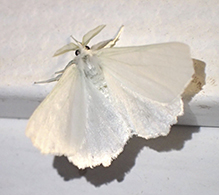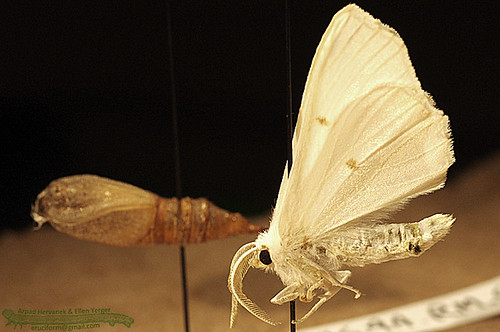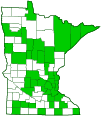elm spanworm moth
(Ennomos subsignaria)
Conservation • Description • Habitat • Ecology • Distribution • Taxonomy
|
||||||||
| Hodges # | 6798 |
|||||||
Conservation Status |
||||||||
| IUCN Red List | not listed |
|||||||
| NatureServe | NNR - Unranked SNR - Unranked |
|||||||
| Minnesota | not listed |
|||||||
Description |
||
Elm spanworm moth is a common, medium-sized, typical geometer moth. It occurs in the United States and southern Canada east of the Great Plains. It was accidentally introduced into Europe in shipments of asparagus. It is common in Minnesota. Adults are found in July and August in deciduous forests and woodlands. Larvae are found from late May to early July. They feed on the leaves of a wide variety of deciduous trees and shrubs, including American hophornbeam, apple, ash, basswood, beech, birch, cottonwood, elm, hickory, maple, oak, and walnut. Occasionally a population will experience a sudden, massive increase (eruption). When this happens, large areas of a forest may be defoliated. This is rarely a problem in parks or in yards. Adults have a wingspan of 1⅜″ to 1 9⁄16″ (35 to 40 mm). The antennae on the male are feather-like, with branches on both sides (bipectinate) from the base to the tip. The wings are usually pure white, sometimes tannish white, and are unmarked except for a small black discal spot on the underside. The forewings are broad and have an angled rear (outer) margin. The hindwings have pointed projections along the outer margin. Most adults are entirely white. Some individuals have varying amounts of lime green on the antennae, the abdomen, the legs, and the leading edge (costal margin) of the forewings. The caterpillars are slender and long, up to 1 9⁄16″ (4 cm) in length. The color is variable. Most are green, but the color can range from yellowish green to brown or almost black. Darker colors are more common during outbreaks when population density is high. The upper side of the second, fifth, and eighth abdominal segments have a transverse ridge with a single hair (seta) at each end. |
||
Size |
||
Wingspan: 1⅜″ to 1 9⁄16″ (35 to 40 mm) |
||
Similar Species |
||
Habitat |
||
Deciduous forests and woodlands |
||
Ecology |
||
Season |
||
One generation per year: July to August |
||
Behavior |
||
Adults rest with their wings held flat and spread out, or sometimes with their wings held vertically and tightly compressed above the body. They are active at night and will come to light, often in large numbers. |
||
Life Cycle |
||
The female lays eggs on the underside of twigs. The eggs overwinter. Unlike other loopers, the caterpillars pupate on the leaves of the host, not in leaf litter on the ground or underground. |
||
Larva Food |
||
Leaves of deciduous trees and shrubs, including American hophornbeam, apple, ash, basswood, beech, birch, cottonwood, elm. hickory, maple, oak, and walnut. |
||
Adult Food |
||
Flower nectar |
||
Distribution |
||||
|
Sources |
|||
| 11/10/2023 | ||||
Occurrence |
||||
Common |
||||
Taxonomy |
|||
Order |
Lepidoptera (Butterflies and Moths) | ||
Superfamily |
Geometroidea (Geometrid and Swallowtail Moths) | ||
Family |
Geometridae (Geometer Moths) | ||
Subfamily |
Ennominae (Typical Geometers) | ||
Tribe |
Ennomini | ||
Genus |
Ennomos | ||
The genus Ennomos was formerly placed in the tribe Ourapterygini. An analysis of the the subfamily Ennominae (Beljaev, 2008) proposed a new generic composition of the tribe Ennomini based on unique characteristics of the male genitalia and on general morphology. Beljaev proposed the synonymization of the tribes Ennomini and Ourapterygini. A later molecular sampling of the family Geometridae (Sihvonenet al., 2011) suggested that the Ennomini, Ourapterygini, Nephodiini, and other taxa “constitute a well-supported clade.” This was supported by a more recent molecular analysis of New World Geometridae (Brehm et al., 2019). Brehm agreed with the synonymization of Ennomini and Ourapterygini. Genera formerly in the tribe Ourapterygini are thus transferred to the tribe Ennomini. Ennomini now comprises the highest number of Neotropical genera (more than 100, including undescribed taxa) in a single tribe. The transfer has not been universally accepted. |
|||
Synonyms |
|||
Ennomos niveosericeatus Ennomos subsignarius Eudalimia subsignaria |
|||
Common Names |
|||
elm spanworm (larva) elm spanworm moth (adult) |
|||
Glossary
Costal margin
The leading edge of the forewing of insects.
Seta
A stiff, hair-like process on the outer surface of an organism. In Lepidoptera: A usually rigid bristle- or hair-like outgrowth used to sense touch. In mosses: The stalk supporting a spore-bearing capsule and supplying it with nutrients. Plural: setae. Adjective: setose.
Visitor Photos |
|||||
Share your photo of this insect. |
|||||
| This button not working for you? Simply email us at info@MinnesotaSeasons.com. Attach one or more photos and, if you like, a caption. |
|||||
Babette Kis |
|||||
Ennomos subsignaria elm spanworm moth Ennomos subsignaria, elm spanworm moth, on siding of house, Milwaukee, WI, July 13, 2022. These moths are attracted to light. |
 |
||||
MinnesotaSeasons.com Photos |
|||||
|
|||||

Slideshows |
||
| Elm Spanworm - Hodges#6798 (Ennomos subsignaria Andree Reno Sanborn |
||
 |
||
| Geometridae - Ennomos subsignaria Caterpillars of the Allegheny National Forest |
||
 |
||
About
Elm Spanworm |
||

Visitor Videos |
|||
Share your video of this insect. |
|||
| This button not working for you? Simply email us at info@MinnesotaSeasons.com. Attach a video, a YouTube link, or a cloud storage link. |
|||
Other Videos |
|||
| Elm Spanworm Moth (Geometridae: Ennomos subsignaria) on Wall Carl Barrentine |
|||
About
Jul 11, 2011 Photographed at Grand Forks, North Dakota (10 July 2011). |
|||
| Elm Spanworm Moth Caterpillar (Geometridae: Ennomos subsignaria) on Twig Carl Barrentine |
|||
About
Jun 28, 2011 Photographed at the Turtle River State Park, North Dakota (27 June 2011). Thank you to John and Jane Balaban (@Bugguide.net) for identifying this specimen! |
|||


Created: 11/10/2023
Last Updated:

